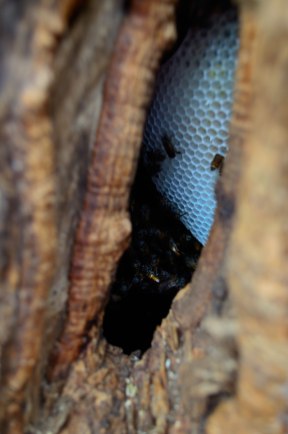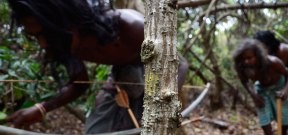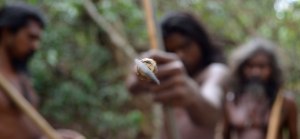Uru warige Wanniya was surrounded by some of his tribesmen when we arrived at his wattle and daub hut in Dambana. As the chief of the Wannila-aththo or Veddhas, the indigenous people of Sri Lanka, his wisdom and counsel are constantly sought after. His serious eyes held a welcoming glow as I offered him a sheaf of betel leaves and then placed both my hands in his in the way of the traditional greeting of the Wannila-aththo. “Hondamai,” we said to each other, meaning “all is well”. But like many of the phrases and words in the Veddha language, the connotation of the expression changes along with the situation at hand.

Uru warige Wanniya in conversation with us
I stood by and watched as my friend, took her turn to greet the Nayaka Aththo (Chief of the Wannila-aththo) and presented him with our gift of dried tobacco leaves, areca nut and limestone. As he sat cross-legged on a reed mat strewn on a ledge and spoke about the ways of his people, I noticed that only his snowy beard and salt-and-pepper hair pulled into a casual knot gave us an inkling of his age. His body looked strong and remarkably wrinkle-free, although his oldest son, next in line to lead the Wannila-aththo, is about 42 years old.
Throughout most of our conversation and even during our greetings I found that the ready smile of the average Sri Lankan person was missing in the faces of the Wannila-aththo gathered in the little hut. Although their expressions weren’t quite what you’d call stern, they were serious with a gentle, knowing undertone. This was apparently the way of these people, we later learned from Nishantha, our guide; they hardly displayed their emotions. There was scarcely any crying at the funeral ceremonies of the Wannila-aththo, said Nishantha. Perhaps, living as one with nature for centuries had familiarized them with the cycle of life to such an extent, that life as a whole had become something to accept calmly. The word Wannila-aththo itself means ‘forest beings’.
Our discussion with the Nayaka Aththo was in part quite sobering. With laws banning hunting, their children beginning to attend mainstream schools, increasing numbers of Veddhas venturing out into cities in search of jobs and modernisation inching its way towards their settlements, their traditional way of life has long since begun to erode. Acutely aware of this fact, the Nayaka Aththo said, “There is next to nothing that can be done about it.” The tiredness in his eyes reflected the grave responsibility of the herculean task he had come to inherit.
Still, he does everything in his power to ensure that the ways of his people are preserved. Evidence of this was by his side: an assortment of bottles containing various hued liquids. This was the Nayaka Aththo’s collection of herbal medicines and oils prepared according to the age-old knowledge of his people, handed down from generation to generation through centuries. This was different to Ayurvedic medicine practised in the rest of the country, he said. It was his manner to speak only the language of his tribe although he understood us when we spoke to him in Sinhala.

We are led into the jungle
Soon after our chat with the Nayaka Aththo we followed four of the Wannila-aththo into the jungle where we enjoyed the most unforgettable treat: honey made by wild bees. They were quite docile really, for wild bees 🙂 Only one of the Wannila-aththo got stung; but he had his hand deep inside the burrow in the tree, where the bees had built their nest. It was a bit difficult to imagine that the white honey-comb he pulled out of the tree was something natural; the hexagonal wax cells were formed so perfectly that it seemed more likely that humans had made it and put it there.

A beehive is found!

Reaching into the burrow for the honeycombs

Bee-sting!

The honeycomb in offering to the Yakshas
Before sharing the honeycomb, an offering was made to the Yakshas, the ancestors of the Wannila-aththo, so that they would ensure that each time a visit was made into the jungle there would be an abundance of honey. Each bite into the wax would spill drops of the yummiest honey I’d ever tasted. I’m not generally fond of bee’s honey, but this was slightly more syrupy than the bottled stuff I was used to. And it was sweet, but not cloyingly so. It dribbled out of the waxy cells and down my hand. It was the most delicious, glutinous mess. Of course, you have to watch out for the larvae 😀 But one thing is for sure: hereafter my mouth will water every time I see a creamy white honeycomb.

Honey drips out of the waxy cells

Dancing and singing is the most preferred way for the Wannila-aththo to celebrate – this time it is caused by the discovery of honey
A display of archery followed, which unexpectedly gave up the hiding place of a Star Tortoise. The bows and arrows are all hand-made by the Wannila-aththo themselves, and after one of us unwittingly detached the point of an arrow while pulling it out of a tree it had wedged itself in, we watched as it was carefully mended.

The traditional hunting method of the Wannila-aththo

The broken arrow is mended

Forest-being

Not only do the Wannila-aththo feel most at-home in the jungle, but the jungle too seems to embrace them as its own
On our way out we re-entered the Nayaka Aththo’s home to buy some of the mouth-watering bee’s honey. I took the opportunity to ask a question that I had forgotten earlier: are the Wannila-aththo really the descendants of the children of Kuveni and King Vijaya, an Indian prince believed to be the father of the Sinhala race?
“That is not true,” said the Nayaka Aththo. “Kuveni was of the Yaksha tribe, one of the tribes living on the island when Prince Vijaya arrived on its shores. We are descendants of the Yaksha tribe too. So while Kuveni is of our tribe, we didn’t descend from her. Our history dates back centuries before Kuveni and Vijaya. Our people have been living in this country for more than 125,000 years.”

The Nayaka Aththo is a mine of folklore and wisdom
We were silent as we digested this information. A flurry of new questions flooded my mind, making it impossible for me to voice any of them. Nishantha, ever the dependable one, must have had his eye on the time, because he said that if we had finished with our questions we should probably leave soon.
“We have questions enough to fill up a whole day!” exclaimed my friend, which brought a twinkle to the eye of the Nayaka Aththo. He smiled; I think he may have even laughed quietly. Maybe at sometime we will come back, just so we can talk for days.
© The Magic-Bean Trippers Prior written consent of the authors must be obtained to reproduce, copy, modify or adapt any part of this blog or any of its contents.

This is awesome. I would love to know a bit more about their medicine and treatments. Keep up the good work.
Hello Akila ayya, it’s a pleasure to have you with us in our journey.
I’m afraid that knowledge is only passed down from generation to generation within the family of the chief. How ever because their way of life is eroding, he is at the moment teaching few of the other Veddas as well. He did say that all of his medicine are made out of different herbs and that the Veddas don’t have the deceases we have, they just get wounds or broken bones for which he makes different herbal oils.
Great post 🙂 Love the honeycomb bit!
Thanx! Yeah it was amazing 😀
This is amazing, we once visited Dambana when Tissa Haamy father of the currrnt chieftain ruled…. I was very very young but like you, I remember wanting to sit for hours and hours asking him questions about the origins of Lanka and it’s people (as told by their tribesmen), and all the tales of their lives in the forests.. coz they have all these beliefs and rules. I just think it’s absolutely fascinating to have such a wealth of knowledge passed down through the ages without a written script.
Truly amazing I wish the government did more to protect, support and preserve their culture.
Hi Nisi! Great to hear from you 🙂 Yeah, we want to do another trip and maybe spend a night or something so that we have more time. But we have no idea when that’ll happen since we have so much travelling lined up already 😀 Will let you know though, if we do sort something out. Would be lovely to have you join us.
Fantastic Haz dear! thumps up!
Thanks, B! 🙂 Looking forward to seeing you soon
Wow, this was really different. Reminded me again that travelling is about experiences with people and places both. Hey is there like a limited time available to spend with Wannila-attho only? Do they let you try out archery? I also have a million questions to ask from you 😀
It was a very different experience for us too. I don’t think there is a limited time. We arranged this one through Nishantha too. He said that it’s possible to camp at a weva near the village of the Wannila-aththo. May also be possible to actually stay at one of their homes. Best person to ask, I would say, is Nishantha. As for your million questions, you know I’ll answer as many as I can, right 😀
the photograph at the beginning of the post is beyond amazing.Never seen anything quite like that.
all photos in your blog are lovely…as are your experiences and thoughts.
N.
Thank you for stopping by our blog and for your encouraging comments 🙂 This photographer certainly is one of the best I’ve seen.